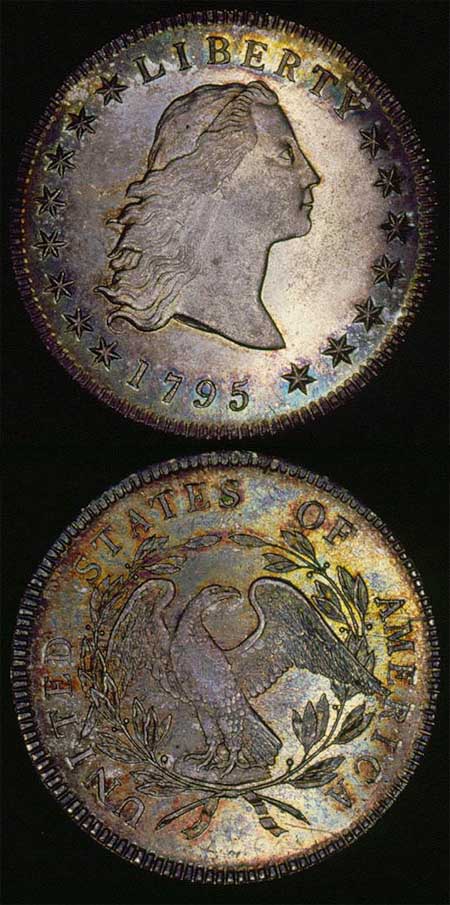Flowing Hair Silver Dollar
The very first US Silver Dollar ever made was produced in 1794 as the Flowing Hair Dollar. This coin did not have a denomination indicator such as '1 D.' Or 'One Dollar' - So the denomination was simply discerned by the diameter size of the coin and the lettering on the edge: 'HUNDRED CENTS ONE DOLLAR OR UNIT'. It depicted Lady Liberty as a young woman, unadorned, hair flowing freely, symbolizing the new nation formed just a few years before. Today, you can acquire the 2020 “Flowing Hair” Dollar! The obverse is graced by a confident, young Lady Liberty, hair freely flowing in the wind as she boldly faces the future draped in an American flag.

Flowing Hair Dollar
Dollars with heft: Flowing Hair, Draped Bust dollars By William T. Gibbs
COIN WORLD Staff Pick up one of the nation's first silver dollars – whether it bears the Flowing Hair or Draped Bust design – and take measure of i...READ MORE
Flowing Hair Dollar
Dollars with heft: Flowing Hair, Draped Bust dollars By William T. Gibbs
COIN WORLD Staff Pick up one of the nation's first silver dollars – whether it bears the Flowing Hair or Draped Bust design – and take measure of its heft: This is a substantial coin! It's big (39.5 millimeters in diameter) and heavy (26.956 grams). The diameter is the largest of any U.S. coin struck for circulation, being more than a millimeter wider than the later Morgan, Peace and Eisenhower dollars. It's also the heaviest U.S. silver coin struck for circulation. (Among all U.S. silver coins, only the noncirculating American Eagle silver dollar and 3-inch, 5-ounce America the Beautiful bullion coins are bigger.) The first two U.S. silver dollars are from short series. The Flowing Hair dollar was struck dated 1794 and 1795 only. The Draped Bust dollar, struck with the Small Eagle and Heraldic Eagle reverses, was struck bearing the dates 1795 to 1803 (the 1804 dollar is a post-dated fantasy and is not a part of the main series). Designs for the 1794 Flowing Hair dollar were based on recommendations from numerous government officials. An early version, represented by a unique copper pattern, bears no obverse stars. That first design was rejected and a new die created bearing 15 stars. The first 1794 Flowing Hair dollars were struck on Oct. 15. The coins were the first precious metal coins struck within the walls of the new Philadelphia Mint. A total of 1,758 1794 dollars were delivered by the coiner, although approximately 2,000 may have been struck (some 200 to 300 pieces were substandard and not deliverable). Production ceased because a better press was needed to strike a coin the size of the silver dollar. The new press was completed in May 1795 and used first to strike some 1795 half dollars before being used to strike 1795 Flowing Hair dollars. Just 160,295 examples of the latter were struck before new designs were introduced. Although it's obvious at a glance that the obverse design was changed from the Flowing Hair concept to the Draped Bust rendition of Liberty, it's less obvious that two distinctly different Small Eagle designs were used for the two series. The Small Eagle design used with the Flowing Hair obverse features an eagle standing on a flat rock, within a wreath and UNITED STATES OF AMERICA. The Small Eagle design used with the Draped Bust obverse features an eagle standing amidst billowing clouds, also contained within a wreath and the reverse legend. Both types were struck with the date 1795. The exact date the switch was made is uncertain, although it may have been late September. The Draped Bust obverse continued to be paired with the Small Eagle reverse into 1798, when a new reverse, called the Heraldic Eagle design by coin collectors, was introduced. Again, both reverse types are found paired with obverses dated 1798. Since all dies were produced by hand, numerous die varieties exist offering: overdates, large dates, small dates, small letters, large letters, 13 stars, 15 stars, 16 stars, stars in 9x7, 10x6 and 8x5 configurations, and more. Variety collecting might be the most fun way to collect, although it certainly would entail a substantial financial outlay.

Draped Bust dime | |
| Date of authorization: | April 2, 1792 |
| Dates of issue: | 1796-1807 |
| Designers: | Obverse: Gilbert Stuart-Robert Scot Reverse: (1796-1797): Robert Scot-John Eckstein (1800-1805): Robert Scot |
| Engraver: | Robert Scot |
| Diameter: | 18.80 mm/0.74 inch |
| Weight: | 2.70 grams/0.09 ounce |
| Metallic content: | 89.25% silver, 10.75% copper |
| Weight of pure silver: | 1.20 grams/0.04 ounce |
| Edge: | Reeded |
| Mint mark: | None |
Flowing Hair Silver Dollar For Sale
